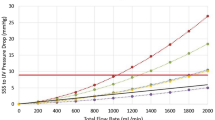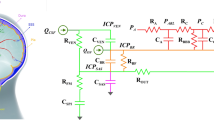Summary
An electrical-equivalent circuit model of the cerebrovascular system is proposed, components of which directly relate to cerebrospinal fluid (CSF) compartment compliance and the determination of intracranial pressure (ICP). The model is based on three premises: 1) Under normal, physiologic conditions, the conversion of pulsatile arterial to nonpulsatile venous flow occurs primarily as a result of arterial compliance. Nonpulsatile venous flow is advantageous because less energy is required to maintain constant flow through the venous system, which comprises 75–80% of total blood volume. 2) Dynamic CSF movement across the foramen magnum is the primary facilitator by which intracranial arterial expansion occurs. Interference of the displacement of CSF during systole results in pulsatile venous flow and increased venous flow impedance. 3) Tissue hydrostatic pressure (here defined as ICP) is a dependent variable which is a function of capillary hydrostatic pressure and the osmotic/oncotic pressure gradient created by the blood-brain-barrier (BBB).
An interference of transcranial CSF movement results in a decrease in cerebral blood flow (CBF) due to inertial effects impeding pulsatile venous flow. Feedback regulation in response to this decreased CBF leads to arteriolar vasodilatation (decreased resistance), thereby lowering the pressure difference between internal carotid and capillary pressures. Assuming no changes in the BBB potential, ICP increases linearly as capillary pressure increases.
Access this chapter
Tax calculation will be finalised at checkout
Purchases are for personal use only
Similar content being viewed by others
References
Auer L, MacKenzie E (1984) Physiology of the cerebral venous system. In: Kapp J, Schmidek H (eds) The cerebral venous system and its disorders. Grune and Stratton, Orlando, pp 169–227
Avezaat C, van Eijndhoven J, Wyper D (1979) Cerebrospinal fluid pulse pressure and intracranial volume-pressure relationship. J Neurol Neurosurg Psychiatry 42: 687–700
Greitz D (1993) Cerebrospinal fluid circulation and associated intracranial dynamics: a radiologic investigation using MR imaging and radionuclide cisternography. Acta Radiol [Suppl] 386: 1–23
Guess H, Charlton J, Johnson R, Mann J (1985) A nonlinear least square method for determining cerebrospinal fluid formation and absorption kinetics in pseudotumor cerebri. Comp Biomed Res 18: 184–192
Marmarou A, Shulman K, Rosende R (1978) A nonlinear analysis of the cerebrospinal fluid system and intracranial pressure. J Neurosurg 48: 332–344
Milnor WR (1989) Hemodynamics. Williams and Wilkins, Baltimore, pp 151–152
Ursino M (1988) A mathematical study of human intracranial hydrodynamics. Part 1 — the cerebrospinal fluid pulse pressure. Ann Biomed Eng 16: 379–401
Author information
Authors and Affiliations
Editor information
Editors and Affiliations
Rights and permissions
Copyright information
© 1998 Springer-Verlag Wien
About this paper
Cite this paper
Bergsneider, M., Alwan, A.A., Falkson, L., Rubinstein, E.H. (1998). The Relationship of Pulsatile Cerebrospinal Fluid Flow to Cerebral Blood Flow and Intracranial Pressure: A New Theoretical Model. In: Marmarou, A., et al. Intracranial Pressure and Neuromonitoring in Brain Injury. Acta Neurochirurgica Supplements, vol 71. Springer, Vienna. https://doi.org/10.1007/978-3-7091-6475-4_77
Download citation
DOI: https://doi.org/10.1007/978-3-7091-6475-4_77
Publisher Name: Springer, Vienna
Print ISBN: 978-3-7091-7331-2
Online ISBN: 978-3-7091-6475-4
eBook Packages: Springer Book Archive




